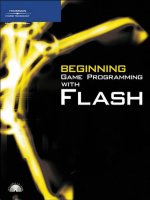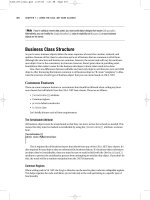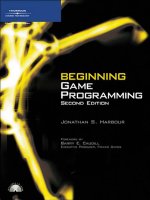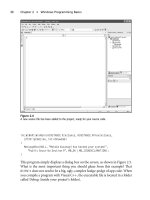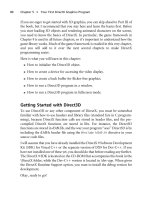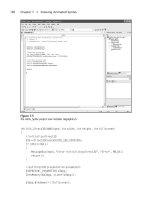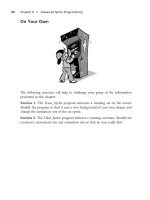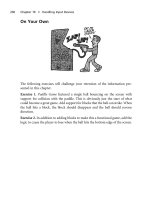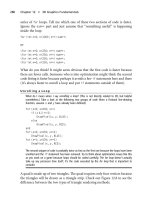Beginning Game Programming (phần 9) ppsx
Bạn đang xem bản rút gọn của tài liệu. Xem và tải ngay bản đầy đủ của tài liệu tại đây (373.98 KB, 14 trang )
to use the same scale for all of your objects in Anim8or. As long as you try to keep
all of the models the same basic size, then you can use the same size value for all of
them. The exception might be a model like the ball, which is necessarily smaller
than the paddle or blocks. In the case of the ball, 50 percent of the size used by the
other models should suffice.
Bash Source Code
The source code for this game is quite short as far as games written in C and
DirectX go. Naturally, there are a lot of places where readability and compre-
hension were more important than shortening the code. But in the end, this is a
very manageable code listing for a complete game. You should have no trouble
working through it as you try to modify the game to suit your own needs.
This game is not at all efficient, as far as simplicity goes. For instance, the code
that fills the playing area with blocks actually loads each block from disk! This is a
very bad way to write a game in general, but the focus here is on keeping the code
as simple as possible so you will be able to focus on how the game works.
On the CD, you’ll find the code for the game.cpp file for the Bash game, and I’m
assuming you’ll use the framework developed in the previous chapter to build this
project. The game.h file remains as it is, save for the following line change:
//application title
#define APPTITLE "BASH"
Note
To conserve space, the entire code listing for
Bash
has been provided on the CD-ROM rather than
listed in thi s chapter. Please load the
Bash
project off the CD-ROM to peruse the source code for
the game (which is about 20 pages lon g).
What’s Next?
There are a lot of fun things that you can do with the Bash game, and I encourage
you to spend some time with the source code to solidify everything you have
learned in this book because Bash covers all of it in a nutshell.
380 Chapter 15
n
Complete 3D Game
What You Have Learned
This chapter explained how to create a complete game from scratch to test the
game framework that you have been learning about and creating in this book.
Here are the specifics:
n You learned how quick and easy it is to create new game models in Anim8or.
n You learned about a simple form of 3D collision detection.
n You learned how to print text using a bitmapped font.
n You learned how to use sound effects to enhance game events.
n You used the keyboard and mouse effortlessly in a real game.
n You put the game framework to the final test!
What You Have Learned 381
Review Questions
The following questions will help you to determi ne how well you have learned
the subjects discussed in this chapter.
1. Briefly, how does the simple 3D collision detection in Bash work?
2. What type of basic geometric shape is used to test for collisions?
3. What type of struct do you use to print each letter in a bitmapped font?
4. What type of object stores the bitmapped font image in memory?
5. How many milliseconds are used to calculate frame rate for one second?
On Your Own
382 Chapter 15
n
Complete 3D Game
Rather than provide two exercises in this last chapter, I have decided to just list
some of the new features that you might add to the game. You might consider
trying these exercises, but don’t limit yourself to just these ideas.
n Add the ability to toggle the wireframe view for destroyed blocks
on or off.
n Add new levels with some creative geometric block formations.
n Add ‘‘lives’’ so that there is a penalty for missing too many balls.
n Add powerups to enhance gameplay (firepower, multiple balls,
and so on).
n Add ball position indicators to the screen edges to help the player
with depth.
On Your Own 383
This page intentionally left blank
3D files, converting, 344
3D graphics, 265–294
Caretesian coordinate system, 268–270,
272–273
Cube_Demo program, 288–294
framework, modifying, 282–288
lighting conditions, 272
matrixes, 271
perspective, 272
programming, steps, 267
quads, 274–275
creating, 279–282
triangles, 279–281, 289–290
scene, 267–272
textured cube demo, 282
texturing, 273–275
unrolling a loop, 280
vertex buffer, 275–279
creating, 246–277
filling, 277–278
rendering, 278–279
vertices, 268, 270–272
3D models, 141, 300–302,
343–361
3D files, converting, 344
3DS to X, converting, 344–351
Anim8or, 300–302
Conv3ds utility, 344–345
loading, 351–354
Load_Mesh program, 355–360
MeshView utility, 345–349
optimizing, 346–347
rendering, 354–355
Save As dialog, 349–351
triangle removal optimization, 347–349
Weld vertices optimization, 349
3DS to X, converting, 344–351
A
Abrash, Michael, 8
Add New Item command, Project
menu, 29
Add New Item dialog, 128
Allegro, 7, 60
Anim8or program, 267, 299–340, 373
3D modeling, 300–302
Build menu, 322
Edit menu, 321–322
faces, lines, vertices, 326–330
features, 302–303
Figure Editor, 303
installing, 303–304
interface, 303
Material Editor dialog, 324–328
Materials toolbar, 324
Mode menu, 305, 320
model car, creating, 318–338
frame, 330–333
headlights and taillights, 334–338
wheels, 319–330
windows, 333–334
385
INDEX
Anim8or program (continued )
Object Editor, 302, 306, 320
Object/Point Edit mode, 326,
329, 375
objects, 310–314
moving, 311–313
rotating, 313–314
scaling, 314
Scale mode, 320
scenes, 314–318
creating, 338–340
shading mode, changing,
317–318
Viewport, moving, 315–316
Viewport, rotating, 316–317
Viewport, scaling, 316
Scene Editor, 303
Sequence editor, 303
Smooth Parameters dialog,
323, 325
stock primitives, 305–310
adding, 310
cubes, adding, 309
cylinders, adding, 309
spheres, adding, 305–308
toolbar, 306
Application Settings dialog, 28
artwork, sprites, 136–140
audio support files, 191–194
B
backgrounds and scenery, 233–234
backgrounds, sprites, 139–140
Bash game, 365–380
bitmapped font, 376–378
collision detection, 379–380
models, creating, 373–376
playing, 368–373
source code, 380
BeginScene function, 153
bitmaps, 112–117, 143–144
D3DX library, 114
Game_Init function, 114
graphics file formats, 113
importing, 246–248
Load_Bitmap program, 113–117
loading, 112
Project Settings dialog, 113
bitmapped fonts, 143, 376–378
blitting, surfaces, 103–105
Bloodshed Software, 5
Borland C++, 6
bounding box collision detection,
sprites, 170–178
Build menu, 40
Build menu, Anim8or, 322
C
C++ Builder, 6–7
Caretesian coordinate system, 268–270,
272–273
Celeste, Eden, 142
collision detection, 372, 379–380
sprites, 170–178
ColorFill function, 105
compilation process, 9
compilers, 5–7
concept art, sprites, 141–142
Conv3ds utility, 344–345
cooperative levels, DirectSound, 184
copying files, DirectSound, 187–189
CreateDevice, Direct3D, 82–83
CreateWindow function, Direct3D,
93–94
CSound class, 183–185
CSoundManager class, 183–184
Ctrl+Shift+B, 40
Ctrl+F5, 40
Cube_Demo program, 288–294
cubes, adding, 309
CWaveFile class, 183–184
cylinders, adding, 309
D
D3DX library, 114
Debug folder, 30
Debug menu, 40
Dev-C++ 5.0, 5–7
DirectInput, 20, 26, 213–219
DirectPlay, 20
DirectSound, 181–202
classes, 183
cooperative levels, 184
copying files, 187–189
386 Index
CSound class, 183–185
CSoundManager class, 183–184
CWaveFile class, 183–184
DirectX audio support files, 191–194
DirectX libraries, 189–191
DXUTsound, 182–183
File menu, 187
framework code, 194–195
game files, adding, 195–201
header files, 191
initializing, 183–184
New dialog, 187
Play function, 185–186
Project menu, 191–192
Project Property Pages dialog, 189
reusable source files, 187
sound buffers, 184
testing, 186
utility files, 187
wave files, loading, 184–185
wrappers, 183
Direct3D, 20–21, 80–95
CreateDevice, 82–83
CreateWindow function, 93–94
fullscreen mode, 93–95
Game_End function, 89, 92
Game_Init function, 89
Game_Run function, 91
graphics device, 81
headers, 80
initializing, 81–84
interfaces, 81
keyboard support, 93
library files, 80, 125
Linker, 84–86
MessageBox function, 89–90
presentation parameters, 83–84, 94
Project menu, Properties option, 84
Project Properties dialog, 84–85
DirectX
components, 19
overview, 18–20
DirectX Graphics, 20
DirectX Sound, 20
double buffers, 17, 102
Draw function, 153–154
DrawBitmap function, 72–73
Dungeon Keeper,9
DXUTsound, 182–183
DynamicScroll program, 244–245,
251–260
E
Edit menu, Anim8or, 321–322
EndScene function, 154
event handling, 17–18
Export dialog, scrolling, 248, 250
F
faces, lines, vertices, Anim8or, 326–330
Feldman, Ari, 136, 143–145, 236
Figure Editor, Anim8or, 303
file extensions, 28
File menu, New, 28, 187
frame buffers, 100–102
framework code, 194–195
framework
modifying, 282–288
sprites, 122–140
front buffers, 102
Fuerst, Jessica K., 141
fullscreen mode, Direct3D, 93–95
G
Game Boy Advance, 232
Game_End function, 66, 89, 92
game files, adding, 195–201
Game_Init function, 66, 89, 114,
145–146
GameLoop project, 67–74, 89
DrawBitmap function, 72–73
running, 73–74
source code, 67–71
game loops, real time, 59–74
continuity, 61
defined, 60
GetMessage function, 62–63
PeekMessage function, 63–66
parameters, 64
WinMain, 64–66
real-time, terminator, 61–62
sprites, 146–147
Index 387
game loops, real time (continued )
while loop, WinMain, 61–62
WinMain, limited loop, 60–61
Game_Run function, 91, 146, 372
games, state-driven, 66
GeForce 6600 video card, 266
GetBackBuffer function,
104–105
GetMessage function, 62–63
graphics device, Direct3D, 81
Graphics Device Interface (GDI), 73
graphics file formats, 113
H
Halo, 234
hardware, 10
headers, Direct3D, 80
header files, DirectSound, 191
header files, scrolling,
236–238
header files, sprites, 128–132
HelloWorld program, 29–31
I
images, loading, 154–157
InitInstance function, 44–47
function call, 45
structure, 45–47
input devices, 205–228
keyboard, 206–210
mouse, 210–213
interfaces, Direct3D, 81
J–K
Jedi Knight,9
keyboard, 206–210
CreateDevice function,
207–208
cooperative level, setting,
208–209
data format, setting, 208
device acquisition, 209
DirectInput objects, 206–208
initializing, 208–209
key presses, reading, 209–210
keyboard support, Direct3D, 93
L
library files, Direct3D, 80
library files, DirectX, 189–191
lighting, 82, 272
Linker, Direct3D, 84–86
Load_Bitmap program, 113–117
Load_Mesh program, 355–360
LoadTexture function, 163–164
M
Map Properties dialog, 247, 249
Mappy, 245–250
Mars Matrix, 154
Material Editor dialog, Anim8or,
324–328
Materials toolbar, Anim8or, 324
matrixes, 271
MechCommander, 143–144
MechCommander 2, 144
MeshView utility, 345–349
MessageBox function, 31, 89–90
Mode menu, Anim8or, 305, 320
model car, creating, 318–338
frame, 330–333
headlights and taillights, 334–338
wheels, 319–330
windows, 333–334
mouse, 210–213
cooperative level, setting, 211
data format, setting, 210–211
device acquisition, 211
initializing, 210–211
reading, 212–213
multi-tasking, preemptive, 13–15
multi-threading, 16–17
MyRegisterClass funtion, 47–50
function call, 47–48
structure, 48–50
N
New command, File menu, 28
New dialog, 187
New File dialog, 29
O
Object Editor, Anim8or, 302, 306, 320
Object/Point Edit mode, Anim8or, 326, 329
388 Index
objects, Anim8or, 310–314
moving, 311–313
rotating, 313–314
scaling, 314
offscreen surfaces, 102–105
P
Paddle Game project, 213–228
PeekMessage function, 63–66
parameters, 64
WinMain, 64–66
perspective, 272
platformer games, sprites, 144–145
Play function, 185–186
polled library, 26
preemptive multi-tasking, 13–15
presentation parameters, Direct3D,
83–84, 94
primary surfaces, 102
program basics, 26
programming, 3D, 267
programming overview, 10–11
Project menu, 128, 133, 157, 191–192
Project menu, Add New Item, 29
Project menu, Properties option, 84
Project Properties dialog, 84–85,
123–124, 157–158
Project Property Pages dialog, 189
projects, defined, 27
Project Settings dialog, 113
Q
quads, 274–275
creating, 279–282
triangles, 279–281, 289–290
Quake,82
R
real-time terminators, 61–62
reusable source files, 187
R-Type, 154
S
Save As dialog, MeshView,
349–351
Scale mode, Anim8or, 320
scenes,
3D, 267–272
Anim8or, 314–318
creating, 338–340
shading mode, changing, 317–318
Viewport, moving, 315–316
Viewport, rotating, 316–317
Viewport, scaling, 316
Scene Editor, Anim8or, 303
scrolling, 231–259
backgrounds and scenery, 233–234
bitmap files, importing, 246–248
defined, 233
DynamicScroll program, 244–245,
251–260
Export dialog, 248, 250
header files, 236–238
Map Properties dialog, 247, 249
Mappy, 245–250
ScrollTest program, 238–243
tile-based, 234–243
tile-based backgrounds, 233–234
tile map, 244–250
tiles, dynamically rendered, 243–244
ScrollTest program, 238–243
secondary surfaces, 102–105
Sequence editor, Anim8or, 303
skill level, 7–10
Smooth Parameters dialog, Anim8or,
323, 325
Solution Explorer, 29
sound buffers, 184
source code files, sprites, 124–136
spheres, adding, 305–308
sprite handler objects, 152–154
SpriteLib, 136, 138
sprites, 121–147
3D models, 141
Add New Item dialog, 128
artwork, 136–140
backgrounds, 139–140
bitmaps, 143–144
bitmapped fonts, 143
bounding box collision detection,
170–178
collision detection, 170–178
concept art, 141–142
configuration, 122–124
Index 389
sprites (continued )
defined, 142
Direct3D libraries, 125
drawing, 122
framework, 122–140
Game_Init function, 145–146
game loop, 146–147
Game_Run function, 146
header files, 128–132
platformer games, 144–145
Project menu, 128, 133
Project Properties dialog, 123–124
source code files, 124–136
sprite sheets, 165–169
SPRITE struct, 144–146
transcolor parameter, 140
transparent, 152–164
transparent color, 140
sprite sheets, 165–169
SPRITE struct, 144–146
state-driven games, 66
stock primitives, Anim8or,
305–310
adding, 310
cubes, adding, 309
cylinders, adding, 309
spheres, adding, 305–308
StretchRect function, 105
Super Mario World, 154, 170
surfaces, 100–111
blitting, 103–1025
ColorFill function, 105
creating, 103
double buffering, 102
drawing, 103–105
frame buffers, 100–102
front buffer, 102
GetBackBuffer function, 104–105
offscreen, 102–105
primary, 102
secondary, 102–105
StretchRect function, 105
T
testing, sound files, 186
texturing, 273–275
tile-based backgrounds, 233–234
tile-based scrolling, 234–243
tile maps, 244–250
tiles, dynamically rendered,
243–244
toolbar, Anim8or, 306
transcolor parameter, sprites, 140
transparent sprites, 140, 152–164
BeginScene, 153
Draw function, 153–154
drawing, 157–164
EndScene function, 154
loading images, 154–157
LoadTexture function, 163–164
Project menu, 157
Project Properties dialog, 157–158
sprite handler objects, 152–154
transforms, 82
triangle removal optimization,
347–349
U–V
unrolling a loop, 280
utility files, 187
vertex buffer, 275–279
creating, 246–277
filling, 277–278
rendering, 278–279
vertices, 268, 270–272
video cards, 82, 99–101, 266
Visual C++, 5–7
Visual Studio .NET, 6
W–Z
wave files, loading, 184–185
Weld vertices optimization, 349
while loop, WinMain, 61–62
Win32 projects, 26–31
Windows, defined, 11–12
Windows messaging, 12–13
WinMain function, 26, 31–36, 55
function call, 32–33
HINSTANCE hInstance parameter, 32
HINSTANCE hPrevInstance
parameter, 33
HWND hWnd parameter, 35
390 Index
int nCmdShow parameter, 33
limited loop, 60–61
LPMSG 1pMsg parameter, 35
LPTSTR 1pCmdLine parameter, 33
UINT wMsgFilterMax
parameter, 35
UINT wMsgFilterMin parameter, 35
while loop, 61–66
WinProc function, 26, 50–55
function call, 50–51
parameters, 51
structure, 51–55
WindowTest program,
writing, 40–44
WM_Paint, 55
wrappers, 183
XNA Game Studio, 7
Index 391
By opening the sealed disc container in this book, you agree to the following terms
and conditions. If, upon reading the following license agreement and notice of
limited warranty, you cannot agree to the terms and conditions set forth, return the
unused book with unopened disc to the place where you purchased it for a refund.
License
The enclosed software is copyrighted by the copyright holder(s) indicated on the software disc.
You are licensed to copy the software onto a single computer for use by a single user and to a
backup disc. You may not reproduce, make copies, or distribute copies or rent or lease the
software in whole or in part, except with writte n permission of the copyright holder(s). You may
transfer the enclosed disc only together with this license, and only if you destroy all other copies
of the software and the transferee agrees to the terms of the license. You may not decompile,
reverse assemble, or reverse engineer the software.
Notice of Limited Warranty
The enclosed disc is warranted by Thomson Course Technology PTR to be free of physical
defects in materials and workmanship for a period of sixty (60) days from end user’s purchase
of the book/disc combination. During the sixty-day term of the limited warranty, Thomson
Course Technology PTR will provide a replacement disc upon the return of a defective disc.
Limited Liability
THE SOLE REMEDY FOR BREACH OF THIS LIMITED WARRANTY SHALL CONSIST
ENTIRELY OF REPLACEMENT OF THE DEFECTIVE DISC. IN NO EVENT SHALL
THOMSON COURSE TECHNOLOGY PTR OR THE AUTHOR BE LIABLE FOR ANY OTHER
DAMAGES, INCLUDING LOSS OR CORRUPTION OF DATA, CHANGES IN THE
FUNCTIONAL CHARACTERISTICS OF THE HARDWARE OR OPERATING SYSTEM,
DELETERIOUS INTERACTION WITH OTHER SOFTWARE, OR ANY OTHER SPECIAL,
INCIDENTAL, OR CONSEQUENTIAL DAMAGES THAT MAY ARISE, EVEN IF THOM SON
COURSE TECHNOLOGY PTR AND/OR THE AUTHOR HAS PRE VIOUSLY BEEN NOTIFIED
THAT THE POSSIBILITY OF SUCH DAMAGES EXISTS.
Disclaimer of Warranties
THOMSON COURSE TECHNOLOGY PTR AND THE AUTHOR SPECIFICALLY DISCLAIM
ANY AND ALL OTHER WARRANTIES, EITHER EXPRESS OR IMPLIED, INCLUDING
WARRANTIES OF MERCHANTABILITY, SUITABILITY TO A PARTICULAR TASK OR
PURPOSE, OR FREEDOM FROM ERRORS. SOME STATES DO NOT ALLOW FOR
EXCLUSION OF IMPLIED WARRANTIES OR LIMITATION OF INC IDENTAL OR
CONSEQUENTIAL DAMAGES, SO THESE LIMITATIONS MIGHT NOT APPLY TO YOU.
Other
This Agreement is governed by the laws of the State of Massachusetts without regard to choice of
law principles. The United Convention of Contracts for the International Sale of Goods is
specifically disclaimed. This Agreement constitutes the entire agreement between you and
Thomson Course Technology PTR regarding use of the software.

